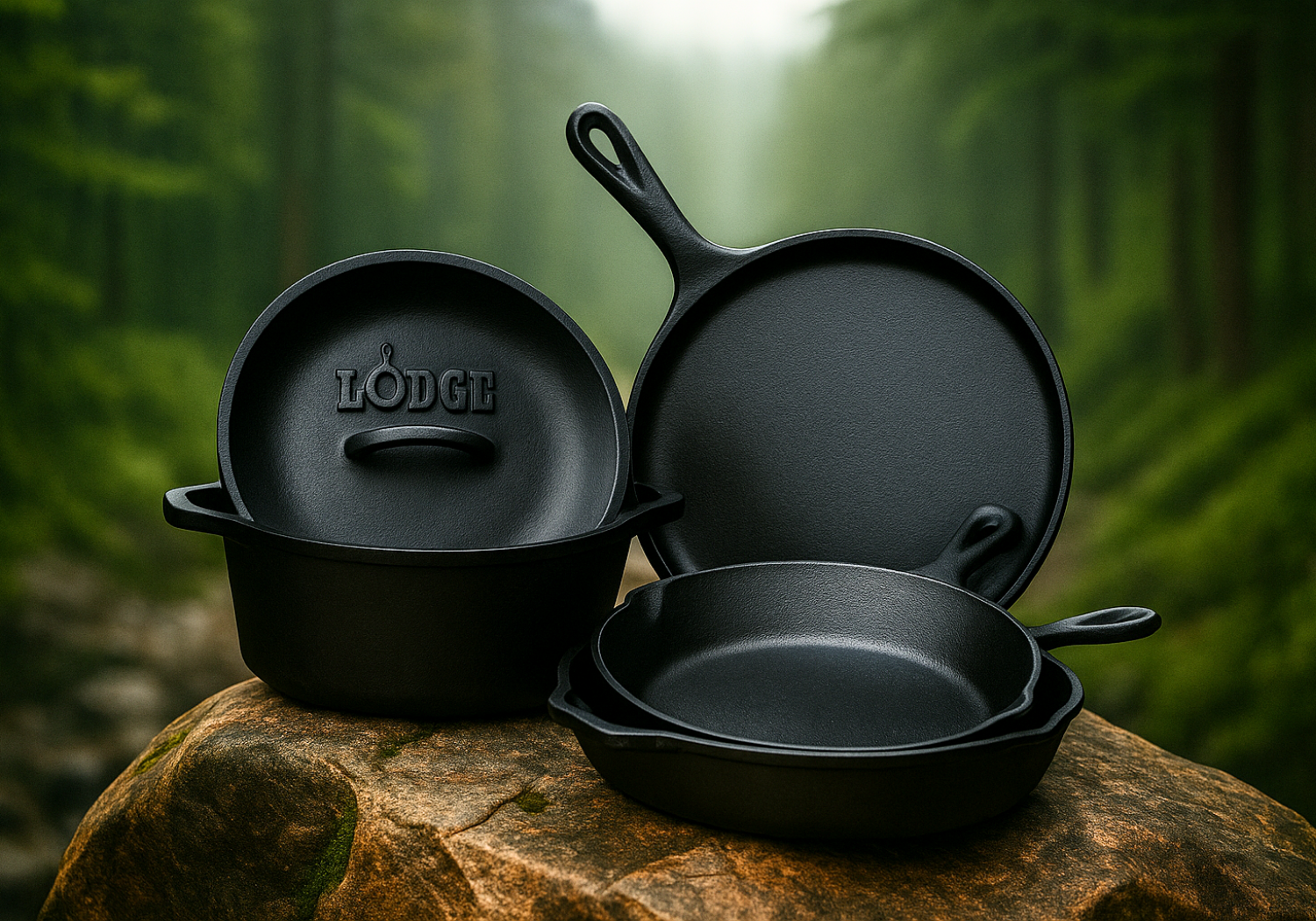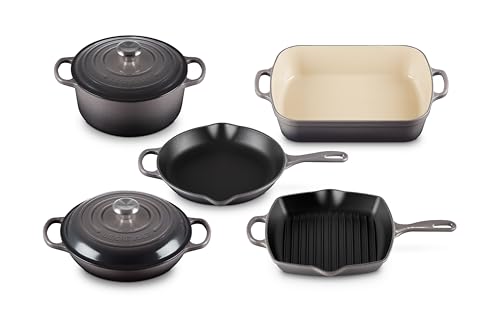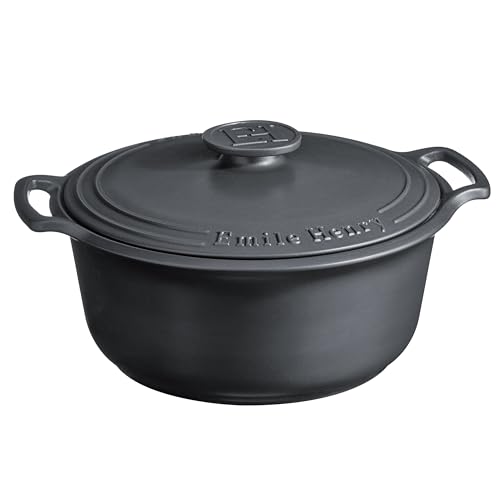The Best Non-Toxic Cookware of 2025
Cookware companies throw around warm-and-fuzzy words like eco-friendly, non-toxic, and healthy to make us feel safe. But when you pull back the curtain, most of it is just marketing designed to sell you pans that are anything but safe.
The Chemicals Behind “Nonstick”
The magic of nonstick comes from a family of chemicals called PFAS (per- and polyfluoroalkyl substances). These are synthetic polymers designed to make cookware surfaces slippery—but they also linger in the environment and in our bodies for decades.
In 2024, the EPA finalized the first national drinking-water limits for multiple PFAS—setting enforceable 4-parts-per-trillion standards for PFOA and PFOS—which is a big reason “PFAS-free” claims matter more than ever.
PFCs (polyfluoroalkyl compounds) are man-made polymers used in nonstick coatings, packaging, textiles, and even insecticides. Studies suggest they can cause tumors and developmental toxicity in animals. According to DuPont’s own website, overheated coatings can cause “polymer fume fever”—flu-like symptoms in humans. The Environmental Working Group (EWG) confirmed pans can reach these dangerous temperatures in just minutes. At 554°F, ultrafine particles begin to come off the pan and embed deeply in the lungs. Recent lab work also shows PTFE and other plastic-coated cookware can shed micro- and nanoplastics during normal use—especially when scratched—adding a new exposure pathway beyond fumes.
PFOA (perfluorooctanoic acid) was once used in Teflon, it stays in the body for years and has been linked to reproductive harm, developmental issues, and liver damage. A CDC survey found PFOA in the blood of nearly all participants tested. Though phased out, it has been replaced by chemicals like GenX—which early research shows may be just as toxic. Also, “PFOA-free” does not mean PFAS-free: Minnesota’s 2025 law explicitly treats PTFE/Teflon as PFAS and bans cookware with intentionally added PFAS.
PFOS (perfluorooctane sulfonate) is labeled by the EPA as an “emerging contaminant”. A Johns Hopkins study found PFOS and PFOA in 300 umbilical cord blood samples, proving babies are being exposed in the womb.
PTFE (polytetrafluoroethylene) is better known as Teflon. It begins releasing toxic gases at 680°F, which are lethal to birds and harmful to humans. Symptoms include headaches, chills, and fever—often called “Teflon flu.” Clinicians still document “polymer fume fever”, and consumer guidance warns that overheating above ~500°F can trigger PTFE fumes. A 2024 study identified PTFE particles shedding from damaged coatings into food—a microplastics concern alongside fumes.
A 2025 Mount Sinai study linked PFAS exposure to a 31% increased risk of type 2 diabetes, further cementing concerns that these so-called “forever chemicals” disrupt metabolism and long-term health.
States are acting: Minnesota now bans cookware with intentionally added PFAS—including PTFE—effective 2025; Colorado’s ban on PFAS in cookware takes effect in 2026; California’s AB 1200 requires online disclosure and on-package labeling of listed chemicals in cookware; and Washington State has adopted lead limits for aluminum/brass cookware—≤90 ppm in 2026 and ≤10 ppm in 2028.
Eco-Friendly or Greenwashing?
I’ve spent years hunting for truly non-toxic cookware. A decade ago, I bought Xtrema ceramic pans—they seemed perfect until every piece cracked, chipped, or pitted within 3 years. That sent me back into the market, and unfortunately, right into the trap of misleading cookware companies.
Here is a list of companies that use “eco-frienly” as a greenwashing marketing scam:
WearEver Pure Living Cookware
Claims: PTFE-free, PFOA-free, cadmium-free, lead-free, “nonstick ceramic coating.”
My Experience: Within seconds on the stove, I smelled strange fumes. When I pressed the company for answers, they contradicted themselves—first admitting PTFE, then denying it, and finally refusing to disclose the actual ingredients in their coating. Their “ceramic coating” is not 100% ceramic, but a synthetic layer that likely contains polymers or PFCs. (Many trendy “ceramic” nonstick lines are actually thin sol-gel—or “quasi-ceramic”—coatings over aluminum; investigations have flagged potential additives like titanium dioxide nanoparticles and siloxanes, and regulators are pushing for ingredient transparency.)
USA Pans with Americoat
Claims: “Environmentally friendly,” “non-toxic,” made from recycled steel, coated with “proprietary silicone.”
Silicone is not the harmless natural material they imply—it’s a synthetic polymer. Once scratched, it can leach into food. And underneath, the pans are often aluminum or steel, which can react and leach metals when the coating fails. (Recent testing and reviews have reported migration of cyclic siloxanes from some silicone bakeware—especially with fatty foods and higher heat—so “silicone = inert” isn’t always true.)
Nonstick Coatings
Including “ceramic coating” pans
Synthetic polymers that degrade within a year of use
Release heavy metals and toxins once scratched or pitted
Unsafe at high heat
Scratched or aging non-stick can shed microplastics into food
Deadly to birds
Aluminum, Anodized Aluminum, Aluminum Foil
Recognized neurotoxin
Disrupts 200+ biological processes
Linked to Alzheimer’s and neurodegeneration
Once scratched, leaches directly into food
Silicone Coatings
Synthetic polymers, not truly “natural”
Scratch damage leads to reactivity and leaching
Toxic Cookware Brands to Avoid
Teflon
T-Fal
WearEver
GreenPan
Earth Pan
Ecolution
Calphalon
Orgreenic
Swiss Diamond
Scanpan
Nuwave
Baccarat
Non-Toxic Cookware Brands to Buy
After years of trial and error, I’ve narrowed down what truly works in the kitchen. These are the safest, most durable, and trustworthy cookware options I’ve found and continue to rely on every day:
Cast Iron (The Best Option in My Opinion)
Lasts a lifetime, naturally nonstick with seasoning
Great for high heat, but heavy and reactive with acidic foods
Cast Iron Brands: Lodge
My Experince: Cast iron cookware has been the most durable. I have cast iron pans from a decade ago that are still perfect. They require seasoning and up keep to keep them ready for cooking.
Tips: Quick sautés with acidic foods are fine in well-seasoned cast iron, but for long acidic braises or all-day tomato sauces, use enameled cast iron to protect seasoning.
How to Easily Season Cast Iron: Preheat oven to 400°F. Wash the skillet with hot, soapy water, dry thoroughly, and coat with a thin layer of high-heat oil or fat, wiping off excess. Bake for 1 hour, then turn off oven and leave skillet inside to cool.
Carbon Steel
Lighter than cast iron
More heat responsive than cast iron
More heat-tolerant than stainless steel
Easy to season, naturally non-stick after seasoning
Carbon Steel Brands: De Buyer
My Experience: I had one carbon steel wok. I’m not really sure what I gave it away. It was great for sauteeing. I should have kept it!
Tips: You have to season carbon steel just like cast iron if you want it to be naturally non-stick.
How to Season Carbon Steel: Wash the skillet with hot, soapy water, dry thoroughly, and coat with a thin layer of high-heat oil or fat, wiping off excess. Then put on cooktop and heat until the oil creates a solid layer. Do this three times for a natural non-stick coating.
Enamel (Porcelain-Coated, Cast Iron, or Steel)
Non-reactive unless chipped
Brands: Le Creuset, Chantal, Staub
My Experience: I bought Chantal enamel cookware—beautiful, durable, but heavy. A decade later I only have two of the pans, as the rest (three) had chipped. I now rely on Le Creuset which I have had for 4 years and still going strong. I bought a set similar to what appears next to this text.
Tips: Use high heat oils and fats to coat the pans before using. I use butter, coconut oil, or Goddess Ghee to be sure food doesn’t stick. I always use low to medium heat with these oils and fats.
100% Ceramic
Inert, withstands up to 1,800°F
Brands: Xtrema, Emile Henry
My Experience: Xtrema failed on durability, but when intact it is safe to use. I cook and bake every day, 3 times a day so they were heavily used. Every piece of Xtrema cracked, chipped, or pitted within 3 years. If you don’t cook often then they will last longer than 3 years.
Tips: Don’t use stainless steel or any metal utensils on ceramic pans, it will scratch them. Also, abrasive scrubbers and scourers will scratch ceramic cookware.
Unglazed Clay / Stoneware
Pure clay or stone, inert
Brands: Miriam’s Earthenware, Pampered Chef stoneware, Ancient Cookware
My Experience: Great for baking, but requires careful handling. Also, hard to clean and will hold stains but is the most eco-friendly and feels great in your hands because it’s naturally made with clay from the Earth. I really want to try Ancient Cookware’s clay curry pots from India. They are handmade with 100% unglazed clay.
Tips: Using parchment paper between the food and stoneware can help with staining. You can also season the stoneware with high heat oils or fats so the stains don’t stick out as much. I would use butter, coconut oil, or Goddess Ghee.
Glass
Borosilicate preferred over soda-lime
Inert, safe for oven and storage (fridge and freezer)
Brands: Pyrex, Anchor Hocking
My Experience: My everyday go-to for baking and storage. Be mindful with the temperature, glass can shatter easily.
Tips: Keep away from direct flames and electric stove top burners. I once had a glass baking dish shatter because it was on the electric cooktop and I didn’t know the burner was left on.
Stainless Steel 18/8 or 18/10
Non-reactive when high quality stainless steel is used (18/8 or 18/10)
Avoid scouring—scratches expose nickel/chromium leaching
Brands: Made In, Cuisinart,
My Experience: A staple in my kitchen for baking and utensils, though older pieces have wear that concerns me.
Caution: Studies show nickel and chromium can leach into acidic foods, especially from new and low quality stainless steel pans, and decrease with repeated use.
The Takeaway
After all my digging, I’ve come to one conclusion: if cookware calls itself nonstick or eco-friendly, be skeptical. Most of the time, these claims are designed to hide synthetic coatings and toxic chemicals.
The safest choices remain the classics—cast iron, carbon steel, stainless steel, enamel, ceramic, glass, and clay. They may be heavier or require more care, but they don’t come with a hidden chemical burden.
So, if a pan says “nonstick” on the label—just walk away.
Let Us Know
Have you tried a brand of cookware not listed above? Share your thoughts in the comments below—I’d love to hear your experiences!
The Research
2025 — Midya
“Forever Chemicals” Linked to Higher Risk of Type 2 Diabetes
Researchers use blood samples to analyze PFAS levels and found higher levels of PFAS were associated with a significantly greater risk of developing Type 2 diabetes in the future.
2024 — Cole
Microplastic and PTFE contamination of food from cookware
Microplastics are a prolific environmental contaminant that have been evidenced in human tissues. Human uptake of microplastic occurs via inhalation of airborne fibres and ingestion of microplastic-contaminated foods and beverages. Plastic and PTFE-coated cookware and food contact materials may release micro- and nanoplastics into food during food preparation.
2022 — The European Consumer Organisation
Half Baked: EU Food Packaging Laws Need a Rethink to Keep Consumers Safe
A consumer test of chemicals leaching from silicone bakeware. Silicone baking moulds are a widely popular, often in-expensive alternative to metal forms, due in part to their non- stick properties, durability, and heat-resistance. Silicone is however not inert and may inadvertently add ‘chemical ingredients’ to cakes and other baked goods that consumers neither expect – nor want.
2013 — Kamerud KL
Stainless steel leaches nickel and chromium into foods during cooking
Toxicological studies show that oral doses of nickel and chromium can cause cutaneous adverse reactions such as dermatitis. Additional dietary sources, such as leaching from stainless steel cookware during food preparation, are not well characterized. This study examined stainless steel grades, cooking time, repetitive cooking cycles, and multiple types of tomato sauces for their effects on nickel and chromium leaching.
2012 — John Hopkins Bloomberg School of Public Health
PFOA and PFOS Detected in Newborns
An analysis of nearly 300 umbilical cord blood samples led by researchers at the Johns Hopkins Bloomberg School of Public Health shows that newborn babies are exposed to perfluorooctane sulfonate (PFOS) and perfluorooctanoate (PFOA) while in the womb.
2000 — CDC
Fast Facts: PFAS in the U.S. Population
The NHANES program of studies was designed by the Centers for Disease Control and Prevention (CDC). It has measured the blood PFAS in the U.S. population since 1999-2000. The purpose of NHANES is to evaluate the health and nutrition of adults and children in the U.S. These data are publicly released in 2-year cycles.








